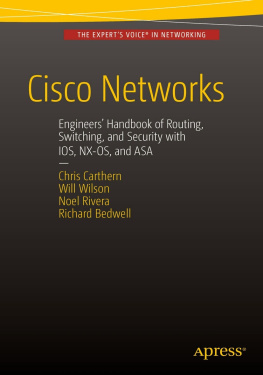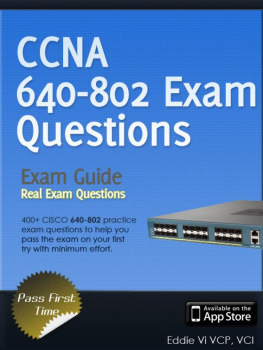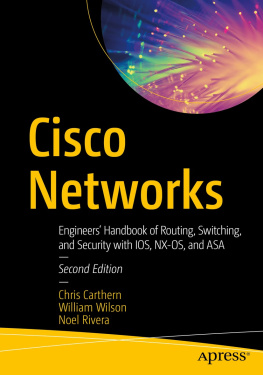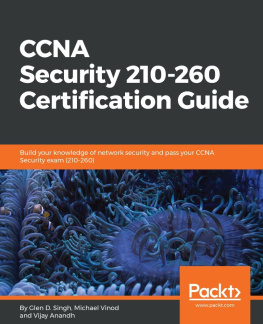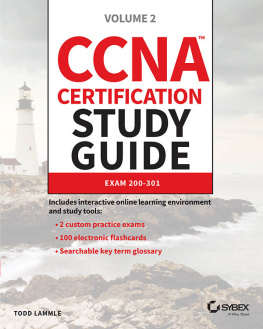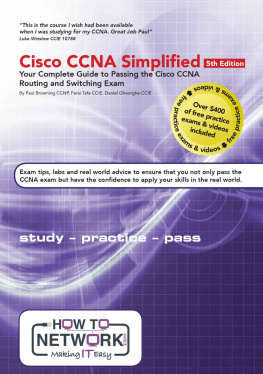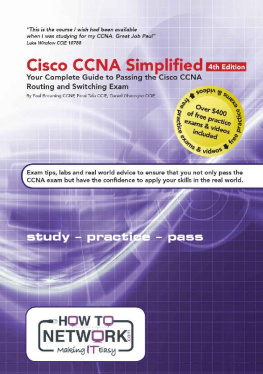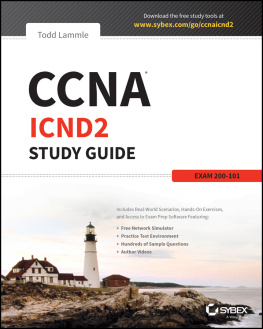Christopher Carthern - Cisco Networks: Engineers Handbook of Routing, Switching, and Security with IOS, NX-OS, and ASA
Here you can read online Christopher Carthern - Cisco Networks: Engineers Handbook of Routing, Switching, and Security with IOS, NX-OS, and ASA full text of the book (entire story) in english for free. Download pdf and epub, get meaning, cover and reviews about this ebook. year: 2015, publisher: Apress, genre: Home and family. Description of the work, (preface) as well as reviews are available. Best literature library LitArk.com created for fans of good reading and offers a wide selection of genres:
Romance novel
Science fiction
Adventure
Detective
Science
History
Home and family
Prose
Art
Politics
Computer
Non-fiction
Religion
Business
Children
Humor
Choose a favorite category and find really read worthwhile books. Enjoy immersion in the world of imagination, feel the emotions of the characters or learn something new for yourself, make an fascinating discovery.
- Book:Cisco Networks: Engineers Handbook of Routing, Switching, and Security with IOS, NX-OS, and ASA
- Author:
- Publisher:Apress
- Genre:
- Year:2015
- Rating:5 / 5
- Favourites:Add to favourites
- Your mark:
Cisco Networks: Engineers Handbook of Routing, Switching, and Security with IOS, NX-OS, and ASA: summary, description and annotation
We offer to read an annotation, description, summary or preface (depends on what the author of the book "Cisco Networks: Engineers Handbook of Routing, Switching, and Security with IOS, NX-OS, and ASA" wrote himself). If you haven't found the necessary information about the book — write in the comments, we will try to find it.
This book is a concise one-stop desk reference and synopsis of basic knowledge and skills for Cisco certification prep. For beginning and experienced network engineers tasked with building LAN, WAN, and data center connections, this book lays out clear directions for installing, configuring, and troubleshooting networks with Cisco devices. The full range of certification topics is covered, including all aspects of IOS, NX-OS, and ASA software. The emphasis throughout is on solving the real-world challenges engineers face in configuring network devices, rather than on exhaustive descriptions of hardware features.
This practical desk companion doubles as a comprehensive overview of the basic knowledge and skills needed by CCENT, CCNA, and CCNP exam takers. It distills a comprehensive library of cheat sheets, lab configurations, and advanced commands that the authors assembled as senior network engineers for the benefit of junior engineers they train, mentor on the job, and prepare for Cisco certification exams. Prior familiarity with Cisco routing and switching is desirable but not necessary, as Chris Carthern, Dr. Will Wilson, Noel Rivera, and Richard Bedwell start their book with a review of the basics of configuring routers and switches. All the more advanced chapters have labs and exercises to reinforce the concepts learned.
This book differentiates itself from other Cisco books on the market by approaching network security from a hackers perspective. Not only does it provide network security recommendations but it teaches you how to use black-hat tools such as oclHashcat, Loki, Burp Suite, Scapy, Metasploit, and Kali to actually test the security concepts learned.
Readers of Cisco Networks will learn
- How to configure Cisco switches, routers, and data center devices in typical corporate network architectures
- The skills and knowledge needed to pass Cisco CCENT, CCNA, and CCNP certification exams
- How to set up and configure at-home labs using virtual machines and lab exercises in the book to practice advanced Cisco commands
- How to implement networks of Cisco devices supporting WAN, LAN, and data center configurations
- How to implement secure network configurations and configure the Cisco ASA firewall
- How to use black-hat tools and network penetration techniques to test the security of your network
Christopher Carthern: author's other books
Who wrote Cisco Networks: Engineers Handbook of Routing, Switching, and Security with IOS, NX-OS, and ASA? Find out the surname, the name of the author of the book and a list of all author's works by series.

